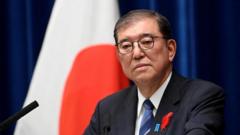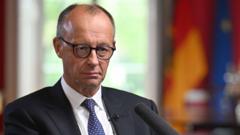In Sydney and across the nation, both major political parties, Labor and the Coalition, commit to addressing the housing crisis amidst rising prices and rents, but experts warn that their strategies may fall short.
**Australia Faces Housing Crisis Ahead of Federal Election**

**Australia Faces Housing Crisis Ahead of Federal Election**
The Australian housing market is under severe strain as affordability plummets, prompting intense political promises ahead of the impending federal election.
Australia's housing market is in turmoil, with affordability becoming a leading concern as the nation approaches its federal election in less than a month. Rising house prices, soaring rents, and inadequate public housing have created a scenario where both buying and renting homes are increasingly out of reach for the average Australian.
The Labor Party and the Liberal-National Coalition have both positioned housing as a central feature in their electoral campaigns, stating their intent to tackle the crisis. With ongoing financial pressures exacerbated by global factors, including economic tensions spurred by policies from the United States, voters are looking for solutions to restore their access to homes.
One of the critical issues contributing to the housing scarcity is that Australia has not built enough residences to accommodate its rapidly growing population. Restrictive planning regulations make it challenging to develop housing in desirable locations, particularly in major cities like Sydney and Melbourne, which tend to have significantly lower population density compared to other global urban centers.
Additionally, the continued decline of public housing has worsened the situation, leading to an increase in homelessness and overcrowding. Climate change is also impacting the liveability of certain regions, as natural disasters such as bushfires and severe storms have destroyed countless homes.
According to a recent survey, Sydney ranks as the world's second least affordable city for home buyers, with average home costs reaching nearly A$1.2 million. The overall trend shows house prices in Australia have skyrocketed by 39.1% in the past five years, while wages have stagnated, resulting in an average prospective homeowner needing about ten years to save for a standard 20% deposit.
The rental landscape is equally grim, with a national increase in rents by over 36% since the pandemic began, positioning Sydney, Perth, and Canberra among the most expensive cities for renters. Sydney now has a median weekly rent of A$773, and rents nationwide have surged.
Discussions around foreign investment and immigration typically arise in the context of the housing crisis. However, experts contend that these factors have minimal impact. Temporary migrants, such as international students, mostly reside in specialized accommodations, and foreign purchases comprise a negligible fraction of the overall housing market.
Both major parties have proposed substantial initiatives to create more affordable housing. Labor aims to construct 1.2 million new homes by 2029, while the Coalition targets 500,000. The Labor Party has introduced a A$33 billion investment plan, facilitating access for first-time buyers through shared-equity loans and additional social housing support. Conversely, the Coalition intends to tackle the crisis by limiting immigration scopes alongside promising infrastructure funding.
Despite these pledges, analysts suggest that both parties' strategies lack the comprehensive nature needed to address the deep-seated issues in the housing market. Reports have indicated the government may not meet its ambitious housing targets, projecting significant shortfalls in new home constructions. The Coalition's call for reduced immigration could impose broader economic burdens while failing to significantly impact housing costs.
The growing crisis underlines the importance of a multi-faceted approach to reform housing policy in Australia. Experts call for a more integrated and long-term vision, indicating that the roads to resolution may be long and complex, yet the urgency for action has finally captured the nation's attention.
The Labor Party and the Liberal-National Coalition have both positioned housing as a central feature in their electoral campaigns, stating their intent to tackle the crisis. With ongoing financial pressures exacerbated by global factors, including economic tensions spurred by policies from the United States, voters are looking for solutions to restore their access to homes.
One of the critical issues contributing to the housing scarcity is that Australia has not built enough residences to accommodate its rapidly growing population. Restrictive planning regulations make it challenging to develop housing in desirable locations, particularly in major cities like Sydney and Melbourne, which tend to have significantly lower population density compared to other global urban centers.
Additionally, the continued decline of public housing has worsened the situation, leading to an increase in homelessness and overcrowding. Climate change is also impacting the liveability of certain regions, as natural disasters such as bushfires and severe storms have destroyed countless homes.
According to a recent survey, Sydney ranks as the world's second least affordable city for home buyers, with average home costs reaching nearly A$1.2 million. The overall trend shows house prices in Australia have skyrocketed by 39.1% in the past five years, while wages have stagnated, resulting in an average prospective homeowner needing about ten years to save for a standard 20% deposit.
The rental landscape is equally grim, with a national increase in rents by over 36% since the pandemic began, positioning Sydney, Perth, and Canberra among the most expensive cities for renters. Sydney now has a median weekly rent of A$773, and rents nationwide have surged.
Discussions around foreign investment and immigration typically arise in the context of the housing crisis. However, experts contend that these factors have minimal impact. Temporary migrants, such as international students, mostly reside in specialized accommodations, and foreign purchases comprise a negligible fraction of the overall housing market.
Both major parties have proposed substantial initiatives to create more affordable housing. Labor aims to construct 1.2 million new homes by 2029, while the Coalition targets 500,000. The Labor Party has introduced a A$33 billion investment plan, facilitating access for first-time buyers through shared-equity loans and additional social housing support. Conversely, the Coalition intends to tackle the crisis by limiting immigration scopes alongside promising infrastructure funding.
Despite these pledges, analysts suggest that both parties' strategies lack the comprehensive nature needed to address the deep-seated issues in the housing market. Reports have indicated the government may not meet its ambitious housing targets, projecting significant shortfalls in new home constructions. The Coalition's call for reduced immigration could impose broader economic burdens while failing to significantly impact housing costs.
The growing crisis underlines the importance of a multi-faceted approach to reform housing policy in Australia. Experts call for a more integrated and long-term vision, indicating that the roads to resolution may be long and complex, yet the urgency for action has finally captured the nation's attention.






















